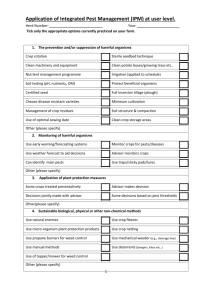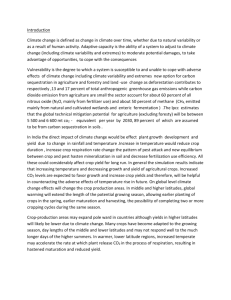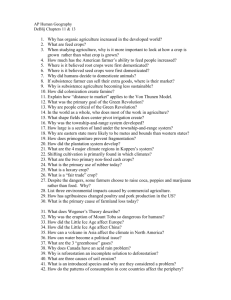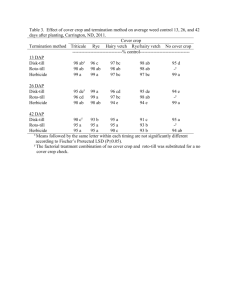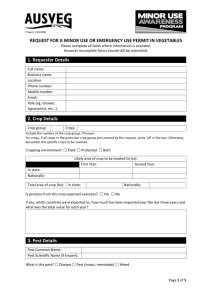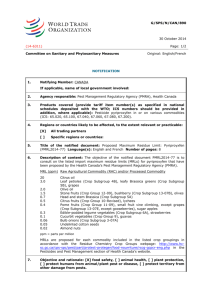IPM and Pesticide application Record Sheet
advertisement
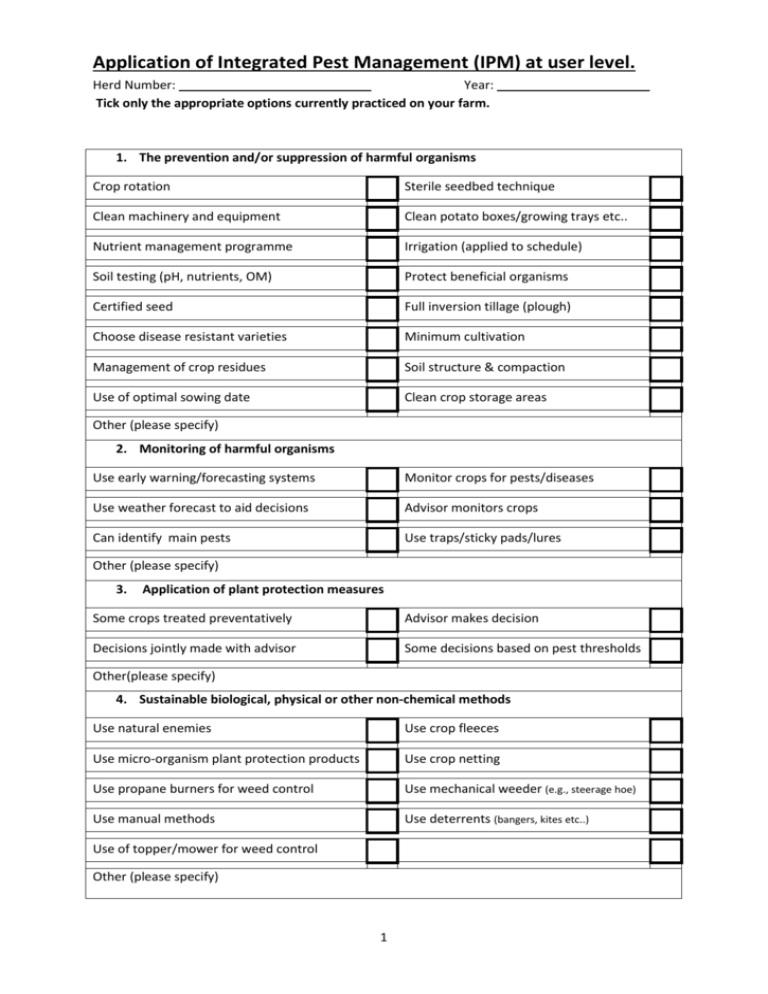
Application of Integrated Pest Management (IPM) at user level. Herd Number: Year: Tick only the appropriate options currently practiced on your farm. 1. The prevention and/or suppression of harmful organisms Crop rotation Sterile seedbed technique Clean machinery and equipment Clean potato boxes/growing trays etc.. Nutrient management programme Irrigation (applied to schedule) Soil testing (pH, nutrients, OM) Protect beneficial organisms Certified seed Full inversion tillage (plough) Choose disease resistant varieties Minimum cultivation Management of crop residues Soil structure & compaction Use of optimal sowing date Clean crop storage areas Other (please specify) 2. Monitoring of harmful organisms Use early warning/forecasting systems Monitor crops for pests/diseases Use weather forecast to aid decisions Advisor monitors crops Can identify main pests Use traps/sticky pads/lures Other (please specify) 3. Application of plant protection measures Some crops treated preventatively Advisor makes decision Decisions jointly made with advisor Some decisions based on pest thresholds Other(please specify) 4. Sustainable biological, physical or other non-chemical methods Use natural enemies Use crop fleeces Use micro-organism plant protection products Use crop netting Use propane burners for weed control Use mechanical weeder (e.g., steerage hoe) Use manual methods Use deterrents (bangers, kites etc..) Use of topper/mower for weed control Other (please specify) 1 5. The pesticides applied shall be as specific as possible for the target pest. Applications usually for multiple pests Resistance development is considered Different modes of action considered Broad spectrum products avoided Different products considered Familiar with different product labels Economics are considered Use advisor to help decide on product(s) Consider following crops Buffer zones are considered Use weed licker for weed control Use of seed dressings Avoid insecticide use where bees are foraging Use drift 75% reducing nozzles Use air assisted sprayer Use drift 90% reducing nozzles Other (please specify) 6. Use of pesticides at necessary levels Use reduced rates of application Use adjuvants to reduce PPP use Partially treat / spot spray fields Applications timed to minimise use Reduce frequency of application Other (please specify) 7. Anti-resistance strategies applied to maintain the effectiveness of the products Use products with multiple modes of action Use robust rates of PPPs Use tank mixes with multiple modes of action Keep abreast of resistance development Familiar with different product labels Other (please specify) 8. Success of the applied crop protection measure Success or failure of intervention is measured Member of discussion group Success or failure of intervention is recorded Results discussed with advisor Crop yields are recorded Other (please specify) 2 Herd No:______________________ Product Name (Trade Name) STRIPE applied. (Buffer reduced) Y/N PCS Number Pesticide Application Record Location LPIS No. Crop (Winter or Spring) (as printed on product label) Type of Nozzle on Sprayer___________________________ STRIPE 75% Area / tonnage treated Year:___________ Pesticide application rate e.g. L/Ha, Kg/ha e.g. Ha or tonnes STRIPE 90% NON STRIPE Date applied Rationale / Reason PU No (pest present, preventative treatment, resistance management, threshold exceeded, crop damaged etc…) Used a contractor Make of Sprayer __________________________ Model of Sprayer ______________________ Tank Capacity ____________ Date sprayer last tested _____________ Notes:
